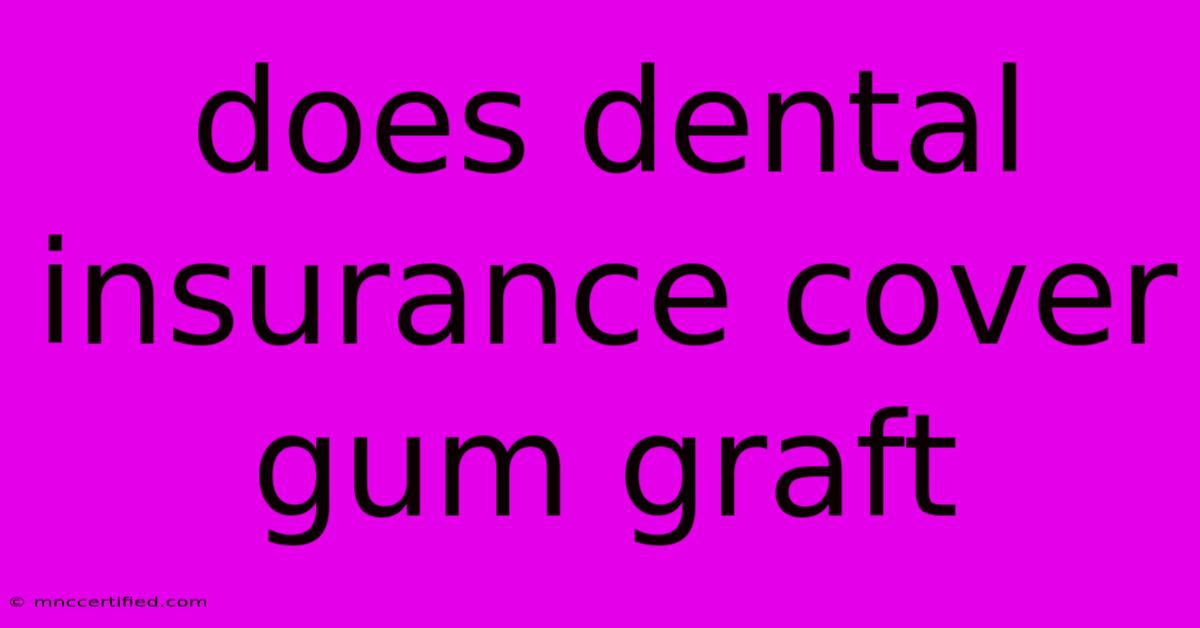Does Dental Insurance Cover Gum Graft

Table of Contents
Does Dental Insurance Cover Gum Grafts? A Comprehensive Guide
Gum grafts, also known as gingival grafts, are surgical procedures used to treat gum recession, a condition where the gums pull back from the teeth, exposing the tooth roots. This can lead to increased sensitivity, tooth decay, and even tooth loss. While gum grafts can be a life-saving solution for many, a common concern is dental insurance coverage.
Understanding Your Dental Insurance Plan:
The answer to whether your dental insurance covers gum grafts is unfortunately not straightforward. Coverage varies greatly depending on your specific plan and insurance provider. To determine your coverage, you need to carefully review the following:
- Plan Type: Some dental plans offer basic coverage, focusing on preventative care like cleanings and fillings. Others offer more comprehensive coverage including major procedures like gum grafts.
- Benefit Maximums: Most dental plans have an annual maximum amount they will pay out for dental services. This limit can impact the overall cost of gum grafts.
- Waiting Periods: Some plans might have a waiting period before certain procedures, like gum grafts, are covered.
- Exclusions: Many dental plans exclude cosmetic procedures, which could include gum grafts depending on the reason for the procedure.
Reasons for Gum Graft Coverage:
In most cases, dental insurance will cover gum grafts if they are medically necessary to address a specific problem, such as:
- Periodontal Disease: If gum recession is caused by gum disease, insurance is more likely to cover a gum graft to prevent further damage and tooth loss.
- Root Exposure: When roots are exposed due to gum recession, making the teeth sensitive and vulnerable to decay, insurance may cover the graft to protect the tooth.
- Bone Loss: If gum recession has led to bone loss, insurance might cover the graft to stabilize the teeth and prevent future complications.
Factors Influencing Coverage:
While the above conditions generally improve coverage chances, several factors can influence the final decision:
- Pre-existing Conditions: If you have a pre-existing condition that contributed to gum recession, your insurance may have limitations.
- Diagnosis and Documentation: Your dentist will need to provide clear documentation of the necessity of the gum graft, including diagnosis, treatment options, and expected benefits.
- Insurance Company Review: Even with a valid medical reason, the insurance company will likely review your claim and determine if the procedure meets their criteria for coverage.
What To Do Next:
If you're considering gum grafts, the first step is to consult your dentist. They can assess your situation, discuss your options, and explain potential costs. Then, contact your insurance company:
- Review your policy: Understand your coverage limitations and benefits for gum grafts.
- Ask about pre-authorization: In some cases, you may need pre-authorization from the insurance company before the procedure.
- Discuss cost estimates: Get a clear understanding of your expected out-of-pocket expenses.
Remember:
Even if your insurance doesn't fully cover the cost of gum grafts, there are still options available. You can explore alternative payment plans, financing options, or even dental discount plans to make the procedure more affordable.
Don't Delay:
Gum recession can lead to serious dental complications. By proactively addressing the issue and understanding your insurance coverage, you can take steps to protect your oral health and maintain a beautiful smile.

Thank you for visiting our website wich cover about Does Dental Insurance Cover Gum Graft. We hope the information provided has been useful to you. Feel free to contact us if you have any questions or need further assistance. See you next time and dont miss to bookmark.
Featured Posts
-
Federal Crop Insurance Planting Dates
Nov 10, 2024
-
Peoples Trust Insurance Company News
Nov 10, 2024
-
Thunderbolts Trailer Unveiled At Ccxp
Nov 10, 2024
-
Backlash Over Scherzingers Response To Brands Us Move
Nov 10, 2024
-
Can You Pay A Bond With A Credit Card
Nov 10, 2024